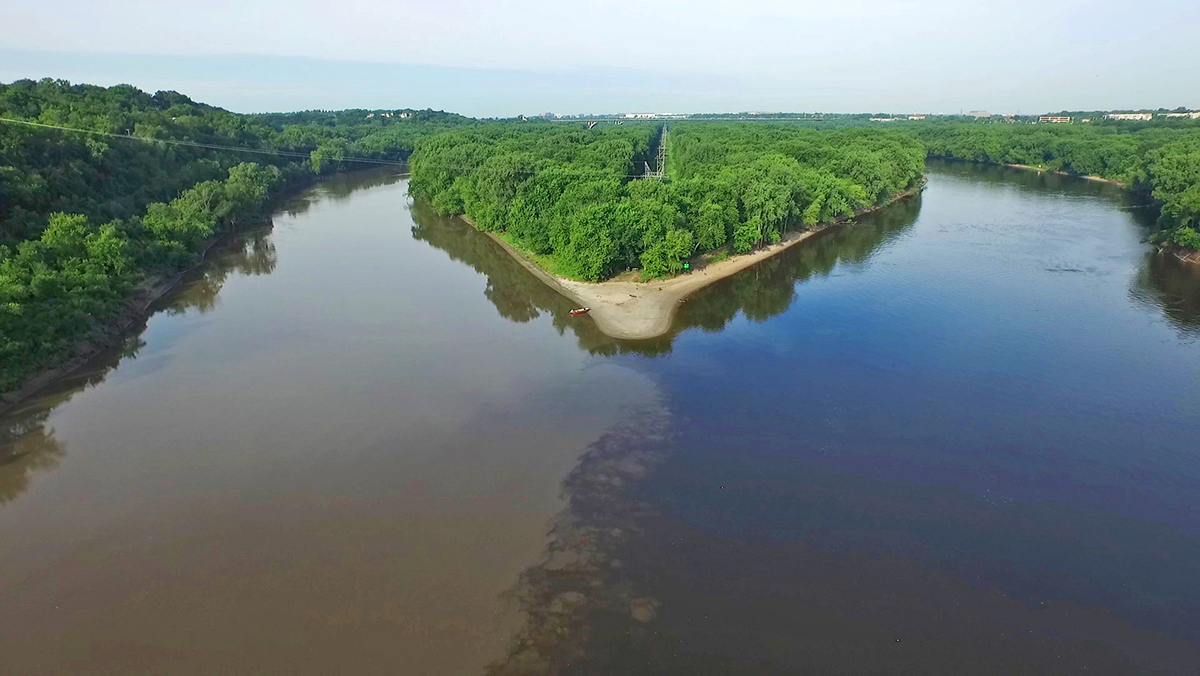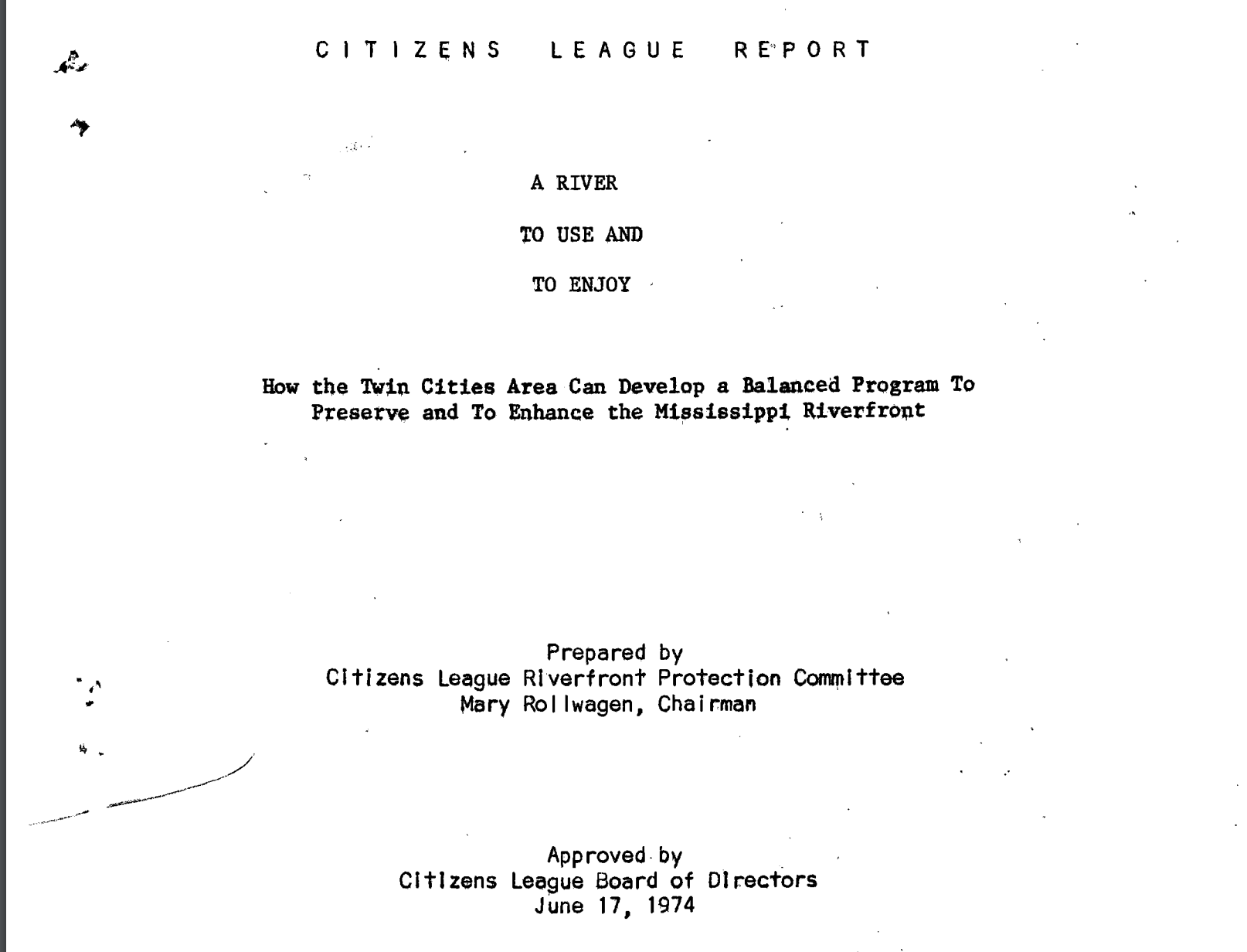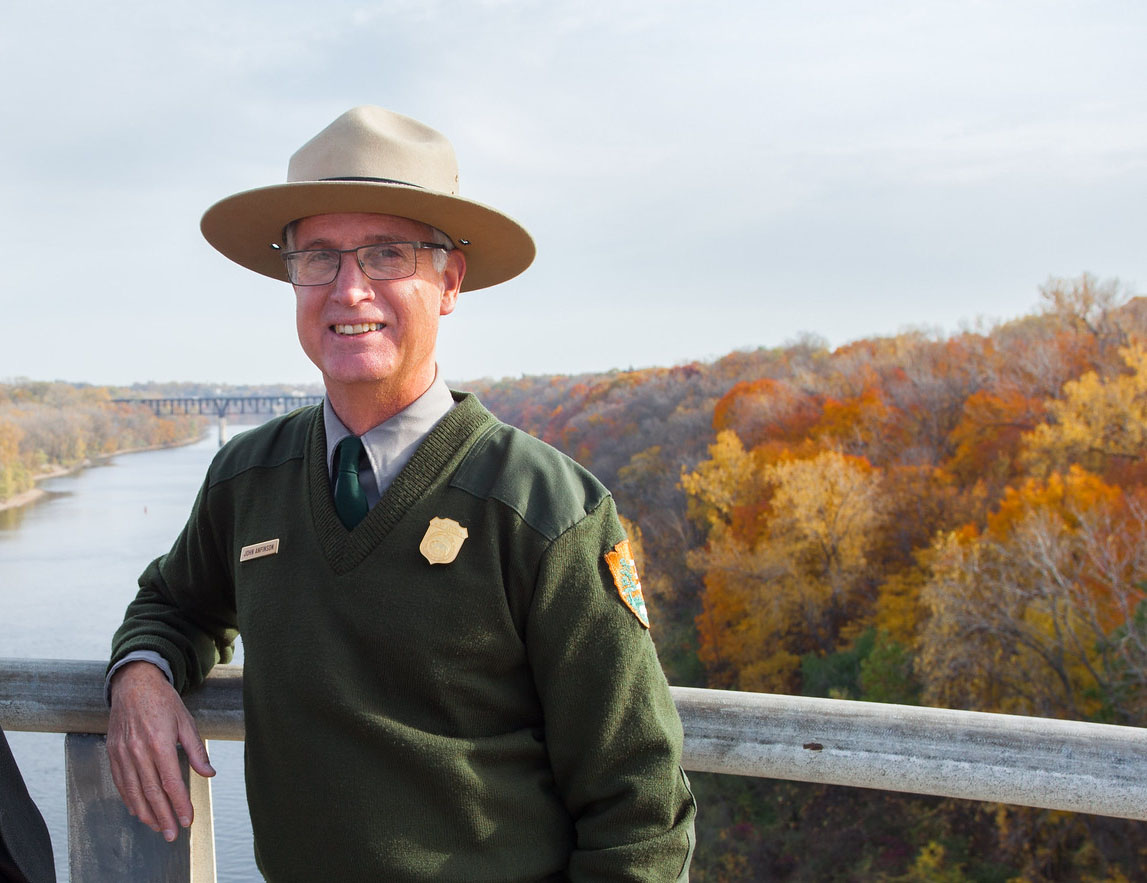The untold story of our national park's founding
You may know that the Mississippi River through the Twin Cities is a national park: the Mississippi National River and Recreation Area (MNRRA). But few of us know how our special river became a national park in the first place.
John Anfinson, MNRRA’s Park Superintendent and a founding board member at FMR, recently researched the story behind how our national park came to be. He learned that this history could come full circle: The riverfront site that started it all is now the potential future home of a new national park headquarters and River Learning Center. (Learn more about the River Learning Center.)
I asked John to share this fascinating story about how our community nearly lost one of the most special spots on the Mississippi River — and how the fight for its future is still paying dividends today.
This story starts in a unique place on the river. Where is it?
The story begins with a unique spot on the river that’s currently home to Watergate Marina. This is the potential future site of the River Learning Center: an environmental education center, recreational hub, and National Park Service headquarters.
It’s located in St. Paul on the east side of the Mississippi River between Hidden Falls and Crosby Farm regional parks. Across the river is Pike Island (Wita Taŋka in Dakota), marking where the Minnesota River flows into the Mississippi. Fort Snelling is just upstream.
The site is sandwiched between the river and a sheer bluff rising some 85 feet to Shepard Road.

What makes this area so significant?
Few landscapes in Minnesota have been so important for so long as the confluence of the Mississippi and Minnesota rivers. This is where the Mississippi opens into the large floodplain river for the first time. The river of Mark Twain, the river most people know, begins at this confluence.
The Dakota call the confluence Bdóte, and it holds special meaning for them. Some Dakota tribes know the confluence as their place of origin. Recent archeological work found deeply buried materials dating back to 5,000 – 3,500 BC, strung out along the bluff edge, overlooking the confluence, testifying to its ancient draw.
These Dakota tribes buried their dead on Pilot Knob (Oheyawahi), which provides panoramic views of the two rivers. At Oheyawahi, the Mdewakanton and Wahpekute bands signed the Treaty of Mendota in 1851, ceding their lands for two reservations far up the Minnesota River.
Eleven years later, U.S. and state military imprisoned more than 1,000 Dakota people there in the floodplain below Fort Snelling, following the U.S.-Dakota War of 1862.
Spanning the decades from 1820 to 1946, Fort Snelling, a National Historic Landmark, holds these and many other stories from early American exploration and colonization through the Civil and Spanish-American Wars, World Wars I and II.
Dred Scott, Buffalo Soldiers and the Military Intelligence Service Language School, where Japanese Americans taught and studied to help their country during World War II, are just some of these stories.
Views from and to the fort still provide a sense of the landscape seen by early American Indians as well as the soldiers who passed through the fort over its 126 years of active use.
How did this special area nearly become lost to development?
Two marinas more than 500 feet apart were cut into what was once floodplain forest and prairie in the 1950s. The upstream marina is abandoned and filling in. The downstream marina is currently active as Watergate Marina.
In 1969, Clayton Rein and a partner acquired this area. They planned to build two 24-story luxury apartment buildings, a 469-car parking ramp, and an amenities building with a restaurant, swimming pool and sauna.
Rein thought his designs were so aesthetically pleasing they would enhance the view and become a tourist attraction for people from around the country. He didn’t comprehend how the strengthening environmental movement would change the course of development projects in the Twin Cities and throughout the nation.
Open opposition to the project began in 1972. The city of St. Paul had anticipated “minimal development” in the Crosby Farm and Hidden Falls area and planned to join the two parks by a trail system. With an understanding of the environmental impacts of floodplain development, the St. Paul City Council supported protecting the site for recreation instead of major development.
The Minnesota Historical Society and Fort Snelling State Park Association also raised opposition to the project, stressing the need to preserve the area’s historic and archeological sites and their environmental setting. The organizations expressed concern over the scenic impact of such tall buildings in this important area.
Still, the first phase of the project won city approval to proceed. In 1973, Rein drove 800 steel pilings, 90 feet down, between the two marinas and began pouring footings for his parking ramp.
Those apartment towers never got built. What stopped them?
This project brought a lot of attention to the importance of the Twin Cities’ riverfront and the lack of protections to guide its future. It came at a time when the environmental movement and environmental protections were really growing.
As Rein was driving his pilings, the Citizens League recognized the Twin Cities riverfront teetered on the cusp of major change. In a 1974 report, the Citizens League called out a variety of threats to the river, such as roadways, floodplain development, dredged material placement and inappropriate housing projects.
The League repeatedly pointed to the Watergate Marina project as an example of what might happen without adequate protections for the river. By 1974 Rein had stopped work, accepting that his project was dead, but river advocates didn’t stop their work.

Never doubt the power of a small committed group of people ... and a well-crafted call to action.
You’ve said that this is the project that birthed our national park. How did that happen?
The Citizens League believed the government framework for guiding riverfront development was insufficient because it did not “recognize the systematic nature of the riverfront” and had failed to understand the riverfront’s regional significance.
It’s this regional significance and need for systematic protection that led first the state, and then the federal government, to award special protections to the Mississippi River through the Twin Cities.
Thanks to community advocacy, on October 18, 1976, Gov. Wendell Anderson signed Executive Order No. 130 establishing the Mississippi River Corridor Critical Area. (Learn more about the Mississippi River Corridor Critical Area.)
Building on the Citizens League assertion that “The opportunity remains for the people of this area to turn the Mississippi Riverfront into a nationally significant recreation area,” river advocates kept pushing for even stronger protections.
In 1988 they succeeded, when Congress established the Mississippi National River and Recreation Area, or MNRRA, as a unit of the National Park Service. (Learn more about the designation of our local national park in the documentary, "Rebirth.")
The site of this failed development is now proposed as the new home for the National Park Service on the river. Tell us more about this vision.
The twist of fate, destiny or good fortune is that the National Park Service and the City of St. Paul have agreed to create a joint River Learning Center and Park Headquarters on the same site where Clayton Rein proposed to build his luxury apartment complex.
This is the very spot that, in important ways, gave birth to our national park.
As the only national park whose mission and purpose is the Mississippi, the park’s headquarters and principal programming center should be on the great river. A place that combines the strongest elements of nature, culture and history in one location would be ideal, and the Watergate Marina site does so in a central location convenient for residents and visitors alike.
Watergate Marina lies above downtown St. Paul on a stretch of river that no longer sees commercial towboat traffic, which makes it safer for paddlers and other visitors. The marina is also situated less than one mile below the park’s Coldwater Spring unit and a 10-acre island the park owns.
This site will allow staff to run programs on and along the river in St. Paul’s largest natural park, offering great views of the river and its floodplain forest. The River Learning Center will allow for a variety of outdoor programs in all seasons.
The city, park and their partners imagine a building that will be light on the land and designed to enhance, not distract from, the river’s beauty. Classrooms, site orientation information, and recreational opportunities will serve all people.
What is the site like today?
Because of Rein’s development attempt, 800 steel pilings still sit lodged in the land between the two marina bays. While a lot of planning needs to happen, the River Learning Center could be built in the same location as Rein’s project, restoring the long-neglected land.
Right now, the land between the two marinas is a jumbled and bizarre landscape. The area is infested with buckthorn. The overgrowth hides piles of concrete and asphalt, miscellaneous steel fragments, parts of boats and trailers, concrete jersey barriers and other things easily left behind and forgotten.
By locating MNRRA’s headquarters as part of a River Learning Center at the Watergate Marina site, we have an opportunity to restore the landscape and environment, creating something worthy of its setting right in the place that led to our national park’s founding.
Support the River Learning Center!
FMR, along with the city of St. Paul, the Great River Passage Conservancy, and Mississippi Park Connection actively supports the River Learning Center as the future (and historic!) home for our local national park headquarters.
Right now, the city of St. Paul is seeking state bond funds to help design the center. You can show your support for this special project by quickly sending a message of support to your legislator.

